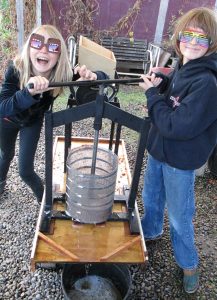
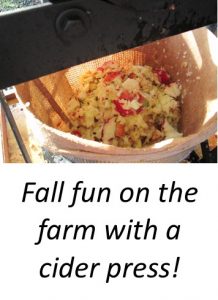
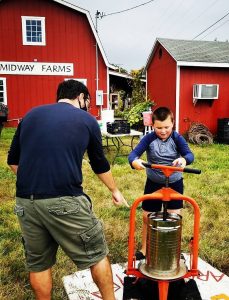
Greetings, Conscientious Food Consumers!
Apples are a quintessential taste of autumn. Whether you enjoy them fresh off the tree or from the market, where would we be without this crisp and colorful fruit for our pies and cobblers, applesauce, muffins and cakes, Thanksgiving stuffing, or our traditional Halloween treats drizzled in caramel?
Apple cultivation and cider-making is as old as America, and many apple stocks migrated westward with the pioneers to the Pacific Northwest and the Willamette Valley. In 2019, apples represented a $39 million chunk of Oregon’s agricultural economy, and are a valuable export crop. One regional grower is even offering its heirloom and other apple woods for the first time so that new orchards can be established.
Apples in abundance also means cider time. The kids in our featured photos had fun learning how to make it the old-fashioned way, with a hand-cranked cider press. You can learn how to do it at home with this helpful publication from the OSU Extension Service.
If you’re a fan of hard cider, there’s plenty of apple varieties to like at the annual Harvest Party celebration put on by 2 Towns Ciderhouse, a Corvallis establishment that has grown into Oregon’s largest craft cider producer of crushes from carefully-selected Northwest grown varieties.
So how do you like — and not waste — “them apples” on your counter? Help them retain their delightful aroma, taste and texture by utilizing the following Smart Strategies and resources:
STORAGE/PRESERVATION
- As directed in our handy A-Z Fruit and Vegetable Storage Guide, segregate apples in the main refrigerator compartment, away from other fruits and veggies;
- Check the apple advice at StillTasty.com;
- Learn about canning and preserving apples from the experts at OSU Extension Service;
- Freeze “them apples” for next month’s Thanksgiving stuffing or other dishes;
- Be sure to include “them apples” in your Freezer Inventory and holiday meal plan!
PRO TIP: Apples, as well avocados, bananas and some other fruits, emit ethylene gas as a normal part of their ripening cycle, and that may accelerate spoilage for any nearby fruit or vegetable items. So keep ’em separate!
USE “THEM APPLES”
- Them apples getting wrinkly or mushy? Prep ’em quick and pop ’em into a batch of muffins, a casserole, a smoothie or a creative dish involving something from your “Eat First” shelf.
- If you want to go “zero waste,” you can even use the core in many dishes (first make sure there’s no mold)!
- Stumped for ideas? Download the “Big Oven” app, type in up to three ingredients, and see what pops up!
- KIDS WILL LIKE THEM APPLES MORE (probably) if they get involved in making apple sandwiches, applesauce, apple bars or other kid-friendly apple recipes at FoodHero.org. It also offers videos and resources in both English and Spanish to help kids learn about nutrition, kitchen skills and even gardening.
- Try this Simply Seasonal baked apple recipe from the Corvallis Sustainability Coalition’s Food Action Team.
*****
This week’s Kitchen Confessions also involves apples!
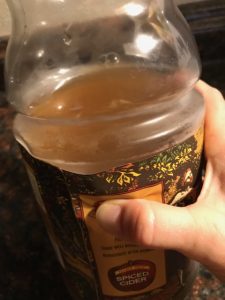
KAREN CONFESSES:
After only a few servings from this bottle of commercial apple cider, I let it get pushed to the back of my fridge where it sat until well past its “Best by” date. It didn’t smell bad but I thought I saw something suspicious floating in the liquid, and tossed it down the drain.
Maybe I made hard cider without realizing it!
$$$ WASTED: About $2.50 (1/2 the cost of the bottle)
LESSON LEARNED: Buy a smaller bottle next time (this size bottle was bit too much for one person to consume). Learn about the fermentation process for hard cider…
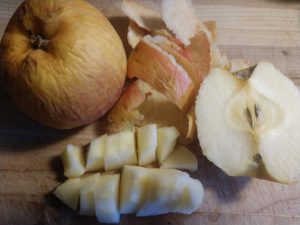
JEANETTE CONFESSES:
Unfortunately I didn’t follow our own advice to store apples in the fridge, and ended up with a handful of shriveled specimens on the counter. But luckily, they weren’t moldy, just a bit dehydrated and still tasty! I was able to peel and dice them, to add some sweetness to a yummy green salad! They also work well this way in oatmeal.
$$$ WASTED: zero!
LESSON LEARNED: Move apples to the fridge within 5-7 days of bringing them indoors.
*****
Enjoy “them apples”! And check out some Northwest-grown varieties you’ve never had before. Just ask at your nearest farm stand or Farmers’ Market.


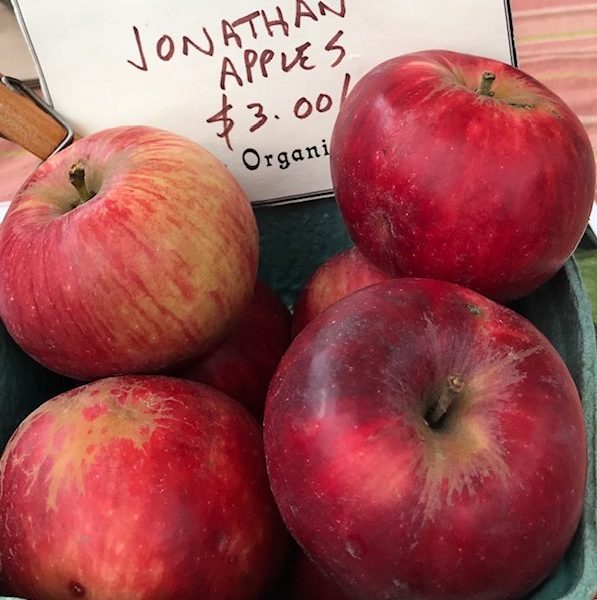
 Check before you chuck it
Check before you chuck it
I always split jugs of fresh cider and put in the freezer for another time. I let it age a bit before using it. ( I do the same with milk)
Hi Pat, thanks for sharing that idea! It’s a great way to avoid waste. Can you please explain how you “age it a bit”? Thanks!
I prefer my cider with a bit of zip so leave it out on a cool porch for a while to ferment –it will build up pressure so don’t do this with a sealed jug! And don’t leave out too long or it will turn too strong and not be enjoyable even as hard cider! I will do the same with the partial jug I have saved in the freezer. I purchase unpasteurized cider so I’m not sure if pasteurized will attain the desired zip.